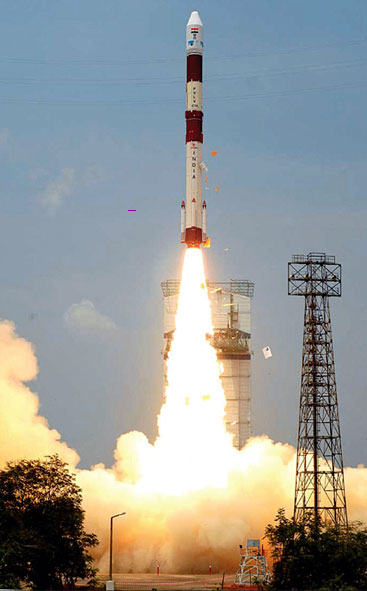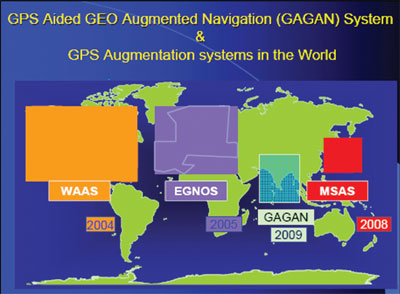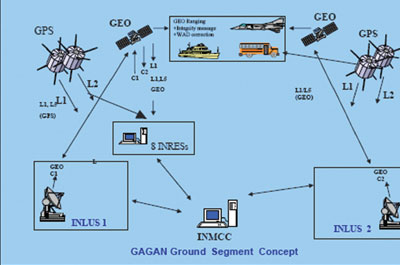|
 Literally
translating to ‘sky’, Gagan is an acronym for
GPS Aided Geo Augmented Navigation System and
is a programme for Indian Regional Navigational
System. Literally
translating to ‘sky’, Gagan is an acronym for
GPS Aided Geo Augmented Navigation System and
is a programme for Indian Regional Navigational
System.
For centuries, navigators, surveyors and explorers
used the sextant and celestial bodies to locate
their navigational position with some accuracy
to avoid tragedy, and to arrive at their intended
destinations. This all changed on 26th June 26,
1993 when the US Department of Defence launched
the 24th Navstar satellite into orbit, completing
a network of satellites costing around $ 12 billion
and creating what is now known as the Global Positioning
System (GPS).
Today with a GPS receiver that costs less than
a few hundred dollars, one can instantly get one’s
location in latitude, longitude and even altitude
to within a few meters.
A combination of minimum four satellites continuously
transmitting signals all over the world can be
fed in to a computerised receiver to give an accurate
fix which is updated every few minutes. It has
changed the way one navigates a ship, drives a
car, locates a tagged container or a mobile phone
etc, but more significantly it has changed military
systems, targeting and intelligence with the incorporation
of GPS in most applications, including missiles
and bombs on way to their targets.
In the 1990s, the Indian Navy was the first Service
to introduce the Magnavox receivers on major ships
and soon the Indian Air Force and Army followed.
The tiny computer box with its small antenna was
fondly referred to as ‘Commander Magnavox’ in
the Navy and when commanding officers wanted to
test navigational skills of their officers, Cdr
Magnavox was purposely switched off; they were
back to the sextant and astro tables.
The applications of GPS has changed most civil
and military applications that need accuracy of
navigation and is today invariably linked into
systems including internet and is very widely
used in military operations and surveys, intelligence
and missile and weapon control and direction.
Technological fantasies and programming possibilities
abound in what GPS can do just like the internet
which itself was a military innovation, has galloped
and all such advances of technology in warfare
are referred to as the Revolution in Military
Affairs (RMA).
The GPS system provides a novel, unique, and
instantly available location for every square
metre on the surface of the earth and new international
standard for locations and distances, for system
providers. Naval and military grids of positions
can be pin pointed and the location of targets
stored in operational plans including nuclear
response linked to decision assist systems for
use in an instant.
With GPS, the military has been given a technology
of unbounded promise, but it needs noting the
GPS system most commonly used is controlled by
USA’s Department of Defense, with a C/A transmission
code with 15 metres accuracy and can be switched
off or fiddled with to mislead some intended recepients.
The US military and its allies have access to
the secure P code and the Wide Area Augmentation
System (WASS) which is more accurate. The US operators
can, at their will, introduce errors in satellites,
just switch them off. That is why the Russians
have gone in for the GLONASS system, where India
is a partner. The Chinese have made the Biedou
system regionally operational with ambitions of
a larger Compass system and the EU has gone in
for the Galileo.
INDIA IS NOT LAGGING
Its major space programmes include the Indian
Regional Navigational Satellite System (IRNSS)-GAGAN
and ship-borne internet communications linked
system with an ISRO launched satellite that would
fructify in the coming two years. The second programme
will assist the Indian Navy become an advanced
network centric warfare (NCW) capable warfighting
arm.
 The
IRNSS will be an autonomous regional GPS navigational
system developed by ISRO under total control of
the Indian Government since other GPS systems
are not guaranteed in hostile situations. The
government approved the project in May 2006, to
be completed and implemented by 2012. A goal of
complete Indian control has been articulated,
with the space segment, ground segment and user
receivers all being built in India with source
codes. The
IRNSS will be an autonomous regional GPS navigational
system developed by ISRO under total control of
the Indian Government since other GPS systems
are not guaranteed in hostile situations. The
government approved the project in May 2006, to
be completed and implemented by 2012. A goal of
complete Indian control has been articulated,
with the space segment, ground segment and user
receivers all being built in India with source
codes.
It is unclear whether the Russian GLONASS will
be linked to the IRNSS project or feed additional
technical support to enable its completion.
The proposed IRNSS system consists of a constellation
of seven satellites and a ground support segment.
Three of the satellites in the constellation will
be placed in geostationary orbit over the Indian
Ocean located at an apogee of 24,000 km with atomic
clocks and electronic equipment to generate the
navigation signals.
The IRNSS signals will consist of a special positioning
precision service being carried on L5 (1176.45
MHz) and S band (2492.08 MHz) and broadcast through
a phased array antenna to maintain continuous
coverage and signal strength. The satellites would
weigh approximately 1,330 kg each and their solar
panels will be capable of generating 1,400 watts,
with 20 meters accuracy throughout India and extending
further to 2000km.
The ground segment of IRNSS constellation would
consist of a Master Control Center (MCC), ground
stations to track and estimate the satellites’
orbits and ensure the integrity of the network
(IRIM), and additional ground stations to monitor
the health of the satellites with the capability
of issuing radio commands to the satellites. The
control centre would estimate and predict the
position of all IRNSS satellites, calculate integrity,
make necessary ionospheric and clock corrections
and run the navigation software. In pursuit of
a highly independent system, an Indian standard
time infrastructure would also be established
by 2012.
THE GAGAN AIR NAVIGATION
SYSTEM LINKED TO USA’S GPS
Gagan is being progressively installed at an
estimated cost of Rs 774 crores (USD 163.516 million
approximately). It is a Satellite Based System
(SBAS) over the Indian air space being implemented
by ISRO and the Airport Authority of India (AAI)
with two down links for seamless navigation and
control of air traffic, with Raytheon of USA as
the contactor.
It will be linked globally with other systems
like WAAS of USA, EGNOS of Europe and MSNAS of
Japan.
Gagan involves development of indigenous technology
in frontier areas with numerous benefits to the
aviation sector and would enable aircraft to navigate
on a straight path/ route instead of navigating
in zig-zag path over land based stations.
This system would also provide coverage of oceanic
areas, which is not possible by terrestrial systems;
improve airport and airspace access in all weather
conditions; enhance reliability and reduce delays;
provide uniform and accurate navigation performance
over the entire airspace; provide fuel efficient
air corridors and provide CAT-I approach without
ground element support.
Additionally the project would result in fuel
savings/efficiency for airlines and enable higher
air traffic within the limited airspace, and the
military could use it for identification of aircraft
and protection of India’s air spaces.
INDIAN NAVY FROM LINK
II TO INTERNET WITH ISRO’S MILTARY SATELLITE C4ISR
On 23rd September 2009, ISRO in a landmark event
launched an oceanmonitoring satellite OCEANSAT
2 and six European nano satellites aboard a Polar
Satellite Launch Vehicle (PSLV) that lifted off
from the Satish Dhawan Space Centre on India’s
Southeastern coast.
Prime Minister Manmohan Singh in a statement
congratulated the ISRO on the successful launch
of OCEANSAT-2, which he said “will herald a new
beginning in our understanding of the oceans”.
The ocean monitoring satellite was placed into
its intended 720-kilometer sun synchronous polar
orbit. The 1,000- kilogram satellite is the second
in a series of ISRO remote sensing satellites
dedicated to ocean research. It is dedicated to
data collection that began with OCEANSAT-1 launched
in 1999 and is nearing the end of its operational
life.
A third satellite OCEANSAT-3 is planned for
launch in 2012. OCEANSAT-2 is being used for weather
tracking and forecasting and the identification
of potential fishing zones, ocean condition forecasting,
coastal zone studies and providing inputs for
weather forecasting and climate studies. The Indian
Navy has access to the data and bathymetric studies
assist Anti Submarine Warfare among other military
uses.
The Indian Navy has not been lacking in the field
of its efforts to augment its C4ISR (concept of
Command, Control, Communications, Computers, Intelligence,
Surveillance and Reconnaissance) capabilities.
The Navy has placed a futuristic order worth
$ 2.1 billion for eight of the latest Boeing P-8I
long range maritime reconnaissance 737s with the
latest C4ISR equipment, which will roll out in
2011, and soon ISRO will launch a Navy dedicated
communications satellite for which terminals are
being installed on all ships to enterprise area
wide network.
On 20th April 2009 ISRO launched RISAT-2, India’s
first synthetic aperture radar (SAR) satellite
built by Israel, similar to Israel’s TECSAR for
imagery at sea and along the coast. RISAT-1 is
being prepared for launch by ISRO along with newer
OCEANSAT series.
In all this, the role of the Weapons Engineering
Electronics Systems Establishment Weapons (WESEE)
needs to be advertised as the unsung heroes in
many technology endeavors of the Indian Navy.
The latest and very significant is the Link II
internetbased digital transmission system, making
sure the Indian Navy stays ahead marching towards
network centricity.
WESEE is the Navy’s own inhouse research and
development agency which began as small unit under
 Ministry
of Defence to harness technologies for improved
communications and amalgamation of the Soviet
weapon systems with Western supplied systems.
WEESE was also assigned to assist in the Navywide
communications network, midlife upgrades of ships
for fitment of new weapon systems on the platforms
being refitted and constructed in India. These
tasks began in earnest with the improved Leanders
of the Vindhyagiri and Godavari class. Ministry
of Defence to harness technologies for improved
communications and amalgamation of the Soviet
weapon systems with Western supplied systems.
WEESE was also assigned to assist in the Navywide
communications network, midlife upgrades of ships
for fitment of new weapon systems on the platforms
being refitted and constructed in India. These
tasks began in earnest with the improved Leanders
of the Vindhyagiri and Godavari class.
Thanks to WEESE in the field of communications
and transmission of digital data the Indian Navy
had already made advances by imbibing a lot from
the US Navy in the eleven Malabar exercises it
has taken part in, when the US CENTRIX M system
for digital internet communications and protocols
was provided to the participating ships.
The Indian Navy has always attempted to leap-frog
by continual modernisation of its fleet to meet
its tactical requirements in the Indian Ocean
Region and has always upgraded its communications,
command and control systems. With a WEESE led
home made LINK 2 internet the Navy swiftly moved
to become a net-enabled digital Navy, as a first
step towards networkcentricity.
The excellent pioneering work was accomplished
by the Navy’s young tech-savvy officers.
The Navy worked closely with Bharat Electronics
Ltd (BEL) , Defence Research and Development Organisation
and Tata Consultancy Ltd and a firm in Chennai
which makes modems, to achieve high standards
of operational network centricity. BEL made the
Link II details public which is an internet modemlinked
ARINC 249 protocol system for ships at sea.
So far, the Indian Navy was receiving low bit-rate
transmission and reception on HF/VHF and INMARSAT
commercial usage which has been very costly.
The Indian Navy and ISRO have announced that
a military communications geo stationary satellite
dedicated to the military will be launched soon
over the Indian Ocean which will give the Indian
Navy ships full internet secure digital transmission
of data, intelligence, maps, situation reports
and internet for social welfare of ship’s crews
in real time with better bit rate.
The exchange between ships and headquarters will
be in real time, so essential when India enters
the nuclear deterrence phase form the seas. The
result will be that the Indian Navy will be marching
towards full net centricity very soon.
The ship based dual offset Gregorian terminals
in 45 inch radomes for transmission and reception
are to be supplied by Orbit Technology Group of
Israel and installed on the Indian Navy ships.
Orbit claims it has worldwide acceptance in the
US, UK and Singapore. The UAV control radomes
fitted in the Indian Navy ships .
INS Taragiri and Vindhyagiri in a revolutionary
move are also supplied by the same company.
The internet terminals linked to the ships CIC
computers, compass and other sensors will be able
to cater for appropriate roll, pitch and yaw.
India’s march towards modern, safe and secure
global positioning, navigation and data transmission
in the Indian Ocean has begun and India believes
in cooperation with the littoral states and to
provide facilities in the Indian Ocean Rim (IOR)
countries.
(The author is a former
DNI of the Indian Navy.)
|